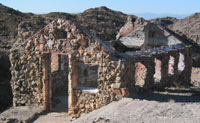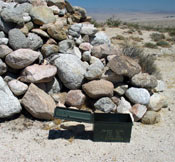Alvord Mine & Spanish Canyon

The Alvord
gold mine, at roughly 35*04.027N and 116*37.704W, offers some nice
ruins and good hiking and exploring. The mine was first located
in 1885, and gradually was added to as it changed hands. A
sturdy vehicle should be able to make it to the ruins  of the rock
cabin. From there you might as well hike, because the road
is covered by a rock fall. There are several foundations and
partially closed adits. We found that the hike to the top,
passing the two lower level adits on the way, was well worth the
effort. The expansive glory hole at the top of the hill is
still mostly open, and there are some nice copper mineral stains
on the walls as well as some expansive views.
of the rock
cabin. From there you might as well hike, because the road
is covered by a rock fall. There are several foundations and
partially closed adits. We found that the hike to the top,
passing the two lower level adits on the way, was well worth the
effort. The expansive glory hole at the top of the hill is
still mostly open, and there are some nice copper mineral stains
on the walls as well as some expansive views.
 of the rock
cabin. From there you might as well hike, because the road
is covered by a rock fall. There are several foundations and
partially closed adits. We found that the hike to the top,
passing the two lower level adits on the way, was well worth the
effort. The expansive glory hole at the top of the hill is
still mostly open, and there are some nice copper mineral stains
on the walls as well as some expansive views.
of the rock
cabin. From there you might as well hike, because the road
is covered by a rock fall. There are several foundations and
partially closed adits. We found that the hike to the top,
passing the two lower level adits on the way, was well worth the
effort. The expansive glory hole at the top of the hill is
still mostly open, and there are some nice copper mineral stains
on the walls as well as some expansive views.From
the mine you can return to the power line road, take it east, then
return north into the Alvord Hills to the mouth of Spanish Canyon
at approximately 35*04.109N and 116*35.698W. You will probably
need four wheel drive to traverse the sandy wash to the head of the
canyon, but it's well worth it. There are some colorful rock
formations  along
the way, and of course the real treat is the well preserved cut at
the very head of the canyon where the pioneers using the Spanish
Trail dug out the ridge to ease the passage of their wagons. This
trail was popularized by Antonio Armijo who, following Indian trails,
first passed this way in 1829. A large stone
cairn marks the site. There is also the "Old
Spanish Trail" geocache in the area which we stumbled upon, the second one we've
found without trying. The
canyon provides a colorful, secluded little oasis in an otherwise
nasty stretch of desert. Sit quietly and you can almost hear
the creak of the wagons!
along
the way, and of course the real treat is the well preserved cut at
the very head of the canyon where the pioneers using the Spanish
Trail dug out the ridge to ease the passage of their wagons. This
trail was popularized by Antonio Armijo who, following Indian trails,
first passed this way in 1829. A large stone
cairn marks the site. There is also the "Old
Spanish Trail" geocache in the area which we stumbled upon, the second one we've
found without trying. The
canyon provides a colorful, secluded little oasis in an otherwise
nasty stretch of desert. Sit quietly and you can almost hear
the creak of the wagons!
 along
the way, and of course the real treat is the well preserved cut at
the very head of the canyon where the pioneers using the Spanish
Trail dug out the ridge to ease the passage of their wagons. This
trail was popularized by Antonio Armijo who, following Indian trails,
first passed this way in 1829. A large stone
cairn marks the site. There is also the "Old
Spanish Trail" geocache in the area which we stumbled upon, the second one we've
found without trying. The
canyon provides a colorful, secluded little oasis in an otherwise
nasty stretch of desert. Sit quietly and you can almost hear
the creak of the wagons!
along
the way, and of course the real treat is the well preserved cut at
the very head of the canyon where the pioneers using the Spanish
Trail dug out the ridge to ease the passage of their wagons. This
trail was popularized by Antonio Armijo who, following Indian trails,
first passed this way in 1829. A large stone
cairn marks the site. There is also the "Old
Spanish Trail" geocache in the area which we stumbled upon, the second one we've
found without trying. The
canyon provides a colorful, secluded little oasis in an otherwise
nasty stretch of desert. Sit quietly and you can almost hear
the creak of the wagons!